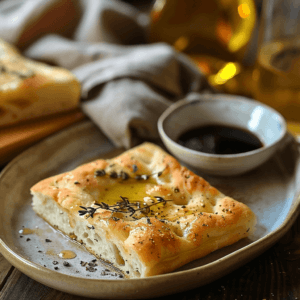
No-Knead Focaccia Recipe
Bake delicious no-knead focaccia at home with this simple recipe! Learn how to make flavorful, airy focaccia with minimal effort. Perfect for beginners. Get the recipe now!
Ingredients
- 4 cups bread flour or all-purpose flour plus more for dusting
- 2 tsp salt
- 2 tsp instant yeast or 2 1/4 teaspoons 7g active dry yeast
- 1 1/2 cups (lukewarm water
- 1/2 cup extra virgin olive oil plus more for greasing and topping
- Optional toppings: rosemary sea salt, cherry tomatoes, olives, garlic
Instructions
- Mix Dry Ingredients: In a large bowl, whisk together flour, salt, and yeast (if using instant yeast). If using active dry yeast, dissolve it in lukewarm water with a pinch of sugar for 5 minutes before adding.
- Add Water and Olive Oil: Pour lukewarm water and 1/4 cup olive oil into the bowl with dry ingredients. Stir until just combined into a shaggy, sticky dough. Do not knead.
- First Rise (Bulk Fermentation): Cover the bowl with plastic wrap or a damp cloth and let it rise at room temperature for 12-18 hours, or in the refrigerator for up to 24 hours. The dough should have doubled or tripled in size and be bubbly.
- Prepare Baking Pan and Second Rise: Generously grease a 9x13 inch baking pan with olive oil. Gently pour the dough into the prepared pan. Let it rest and rise for a second proof in the pan for 30-60 minutes.
- Dimple and Top: Preheat oven to 425°F (220°C). Dimple the dough deeply with your fingers, creating wells across the surface. Drizzle generously with remaining 1/4 cup olive oil. Sprinkle with sea salt and optional toppings like rosemary, olives, or cherry tomatoes.
- Bake: Bake in the preheated oven for 20-25 minutes, or until golden brown and cooked through. Rotate the pan halfway through baking for even browning.
- Cool and Serve: Let the focaccia cool in the pan for a few minutes before transferring to a wire rack to cool slightly. Serve warm or at room temperature. Enjoy!
Notes
- Flour Choice: Bread flour is highly recommended for its higher protein content, which develops gluten and creates a chewier, airier focaccia. However, all-purpose flour will also work, especially if you are aiming for a softer, slightly denser texture. If using all-purpose flour, the rising time might be a little faster, so keep an eye on the dough.
- Yeast Activity: Ensure your yeast is fresh and active. If using active dry yeast, always proof it in lukewarm water with a pinch of sugar for 5-10 minutes before mixing with other ingredients. It should become foamy, indicating it's alive and ready to use. If it doesn't foam, your yeast might be old and you should replace it. For instant yeast, you can mix it directly with the dry ingredients.
- Water Temperature: Lukewarm water is crucial for activating the yeast without killing it. Aim for water that feels comfortably warm to the touch, around 100-110°F (38-43°C). Too hot and it can kill the yeast; too cold and it will slow down yeast activity significantly.
- First Rise Time: The bulk fermentation time is flexible but important for flavor development. A longer, slower rise (especially in the refrigerator) will result in a more complex and flavorful focaccia. If you're short on time, a 12-hour room temperature rise is generally sufficient. In very warm environments, the rise may be faster, so check the dough after about 8-10 hours.
- Dough Stickiness: Don't be alarmed by the stickiness of the dough. This high hydration is key to the airy texture of no-knead focaccia. Resist the urge to add more flour while mixing. Use a dough scraper or wet hands to handle the dough.
- Gentle Handling: When transferring the dough after the first rise, handle it gently to retain the air bubbles that have formed. Pouring it out and gently stretching it into the pan is better than aggressively punching it down.
- Dimpling Depth: Dimple the dough deeply and generously. These wells not only create the classic focaccia look but also allow olive oil and toppings to pool and flavor the bread beautifully.
- Olive Oil Generosity: Focaccia loves olive oil! Don't be shy with it. Use a good quality extra virgin olive oil for the best flavor. The oil contributes to the crispy crust and rich taste.
- Baking Pan Size: A 9x13 inch baking pan is recommended for this recipe to achieve a classic focaccia thickness. Using a smaller pan might result in a thicker focaccia that may require a longer baking time.
- Baking Temperature and Time: Oven temperatures can vary. Keep an eye on the focaccia during baking. You're looking for a golden brown color and a cooked-through interior. If it's browning too quickly, you can loosely tent it with foil for the last part of baking to prevent over-browning while ensuring it cooks through.
- Cooling is Important: Allow the focaccia to cool slightly on a wire rack after baking. This prevents the bottom from becoming soggy and allows the texture to set properly.
- Make it Your Own: Experiment with toppings! Beyond rosemary and sea salt, try different herbs, vegetables, cheeses, or even sweet toppings for dessert focaccia variations.